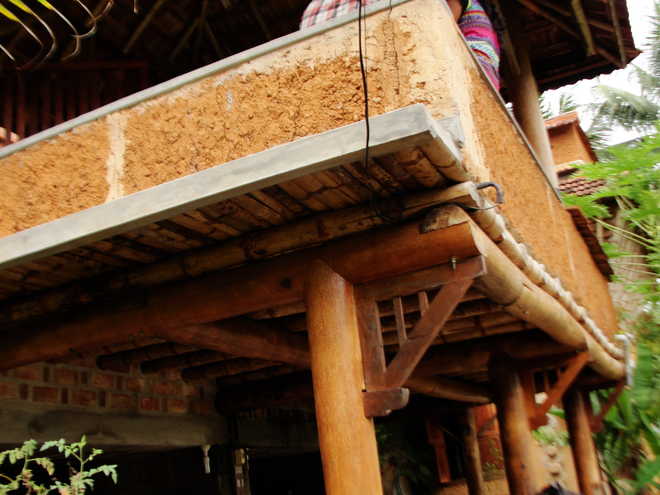
Pappal Suneja
The major advantage of using “green” building material, bamboo, is that it uses practically no energy. Moreover, certain types of bamboo that have the same tensile strength as steel can be used for reinforcement instead of expensive steel. This will lower the cost of construction substantially and also optimise the use of available resources. External uses of bamboo include in structural frames, corner posts, girders, joists, studs, braces, tie beams, king posts, purlins, ridgepoles, rafters, sheathing, roofing, and exterior walls whereas the interior use includes interior columns, wall panels, flooring and kitchen and bath items.
Varieties
Many bamboo varieties are available in India. A few of these are used widely in construction. These include solid (Dendro Calamus Stocksii), lathi (Thrysostachys Oliverii), kallan (Dendro Calamus Strictus), straight (Guada), ordinary nadan (Bamboosa Bam), thornless (Bambusa Balcooa) etc.
Treatment for longevity
Without adequate treatment, bamboo construction can be threatened by borer and white ant infestation and will last for not more than 10-15 years. In ancient times, in African countries people used to dip the bamboo bottom piece in cow’s urine as treatment against borer attack. Another method that was used initially was the use of Copper Sulphate solution immediately after cutting bamboo (this may be not possible usually). The best method, however, to treat bamboo wood is the use of natural reagents borax and boric acid in the ratio 2:3 kg + 45 liters of water in order to make 50-litre solution.
Since the outer layer of bamboo is fully water proof; for the above treatment to be successful, we need to draw holes through and through to the nodes. On keeping bamboo (3.5 meter long poles for easy handling) with the chemical mentioned for two days makes osmosis take place with sap content coming up and the chemical solution being converted into crystals inside.
Beam it up
These can be constructed by connecting two bamboos with 100 mm + 100 mm thick bolts for a maximum span of 3.5 m. If the span goes beyond 3.5 m and up to the 4.5m three bamboos crafted as a triangular beam with through and through bolts can be used. In order to achieve reduced spans, bamboo beams may be separated into different sections.
Stable foundation
These can be used in the foundation as bamboo flat cut friction piles (for bridges and multistoried structures), which may be erected up to 150 mm of the lower level of water. In this case, bamboo must be well-treated and well-compacted to increase the bearing capacity of the soil in which it is eventually embedded. Bamboo piles must be at least 300 mm apart to avoid unnecessary friction and most importantly, bamboo piling should be avoided in case of black cotton soil as it won’t sustain for much longer time. Bamboo reinforcement could be used in foundations in a trapezoidal course and use of lime concrete in the ratio 1.5:3:6 with foundation bed of 450x150 mm.
‘Green’ walls
The most extensive use of bamboo in construction is for the walls and flexible partitions. Posts and beams, generally constitute the structural framework. These are to carry the self-weight of building and loads imposed by inhabitants and weather vagaries. An infill between the framing members is done to finish the wall. The purpose of the infill is protection against precipitation, wind, and insects, to offer privacy and to provide in-plane bracings to ensure the overall stability of the structure when subjected to any of the horizontal forces.
Bamboo is still under-explored in usage and execution as top-grade building material and its availability in our country makes it quite accessible for experiment in construction. Its utilisation shall not only enhance economic development, but also save large forest resources as it is a wood substitute.
Bamboo’s rate of productivity and cycle of annual harvest is higher than that of any other naturally growing resource. For instance, in eight years you will have enough mature material (clumps) to build a comfortable, low-cost house.
Lay it on floor
The floors may be at ground level, and therefore, consist only of rammed earth, with or without a covering of a bamboo matt. The holistic solution is to raise the floor above the ground in order to create a stilt-type construction. This not only improves comfort and hygiene, but also provides a covered storage area underneath. The surface of earth floor is made more durable by paving it with crude bamboo boards that are made by opening and flattening whole culms. The various types used are:
Small bamboo culms: These are directly tied and nailed together
Split bamboo culms: They are split along their length into wide strips.
Roofing solutions
The roof offers protection against extremes of weather including rain, the sun, and the wind, and to provide shelter, clear and usable space beneath the canopy. Above all, it must be durable enough to resist the considerable forces generated by wind and the roof coverings. In this respect, bamboo is an ideal as a roofing material as it is strong, resilient and light weighted one. The bamboo structure of a roof comprises of purlins, rafters, and trusses.
— The writer is an architect based in Ooty



























